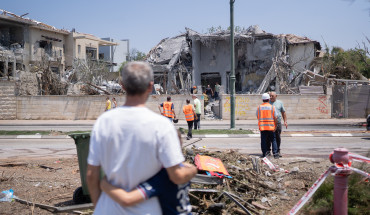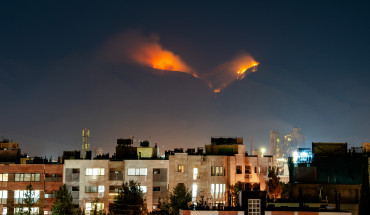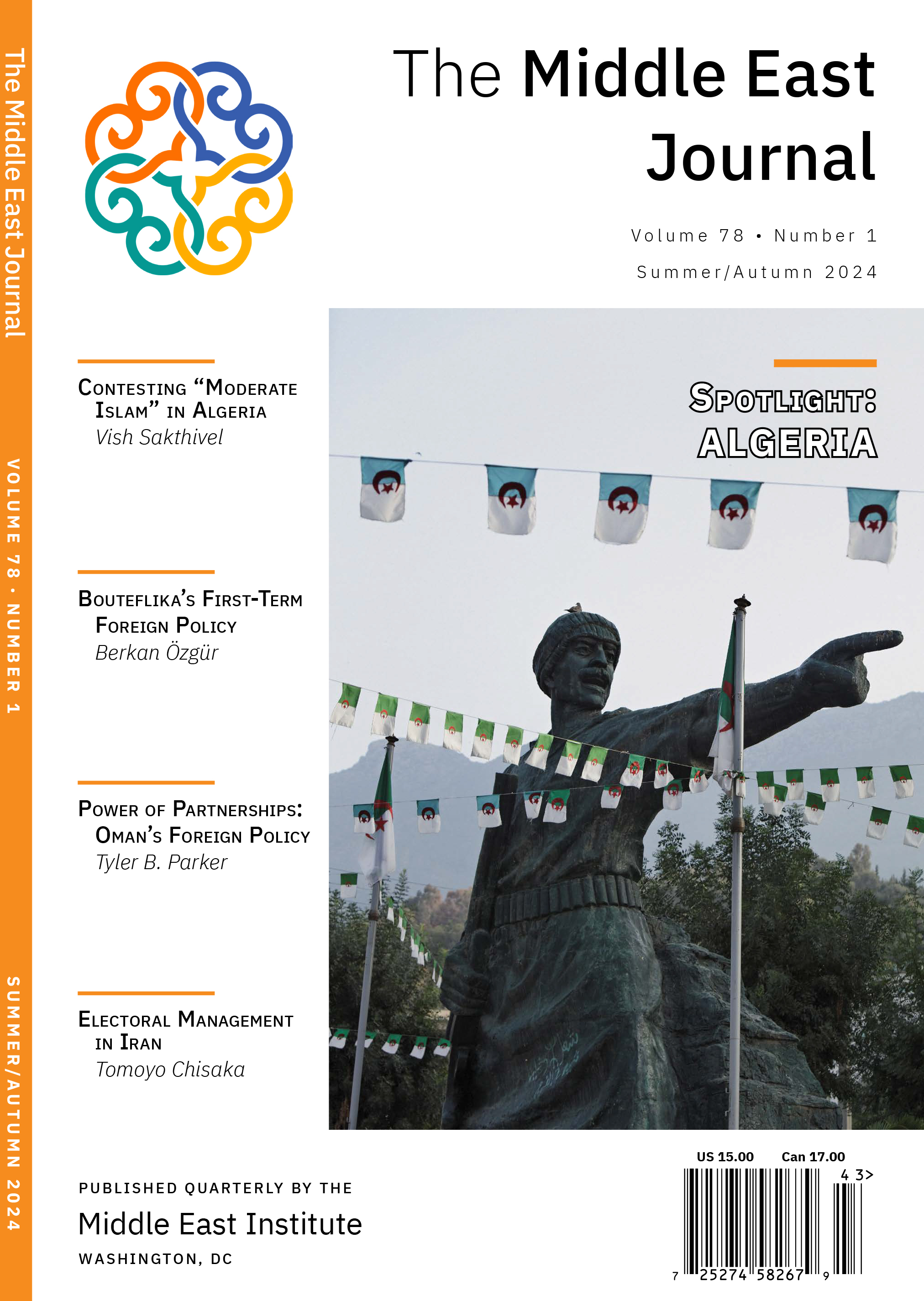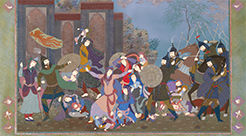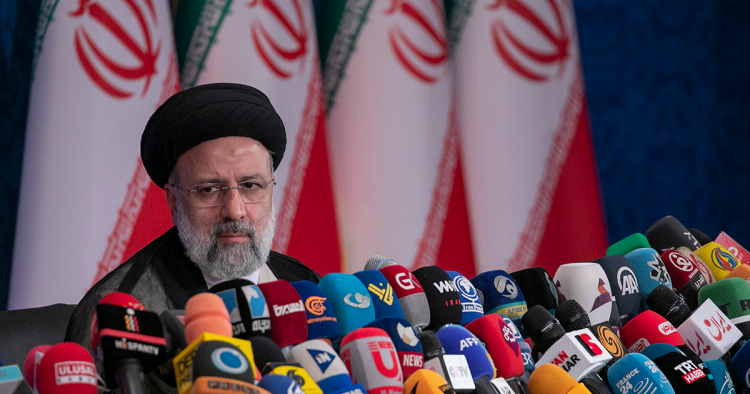Ebrahim Raisi, the eighth president of Iran, has taken over at a time when the Islamic Republic is facing a series of major potential crises. Over the next several decades, these crises could have consequences that will not only affect Iran itself, but may reverberate across the region as well. This article will address the 13 crises facing Raisi’s government and Iranian society more broadly.
Extreme Shiism
The religious community in Iran consists of two different and distinct sectors. The first is “political Islam,” led by Supreme Leader Ayatollah Ali Khamenei, and the second is “religious and traditional Islam,” led by the grand ayatollahs such as Vahid Khorasani and Seyyed Sadegh Shirazi. Political Islam seeks to build on traditional Islam to implement the notion of the “great Islamic civilization.” The mission is to strengthen Shiite thought and spread it to Shiite countries around the world, such as through various Shiite ceremonies and festivals. This includes the Iranian government’s preparations for millions of Iranians to march in Iraq during Arba’een, which commemorates the martyrdom of the third Shiite imam in Karbala. Iran’s reinforcement and development of this ceremony in Iraq is a way to project power over Saudi Arabia, which hosts the annual Hajj pilgrimage.
There is ample evidence, including the extremism of Shiite ceremonies in Iran, that religion is becoming more radical in the Islamic Republic. Although extremist Shiite ideology is far from extremist Sunni thinking (in terms of terrorist and suicidal acts), the fusion of political Islam with traditional Islam could lead to the rise of a new generation of Shiites that lack clear “red lines” in justifying their thoughts, because the leaders of traditional Islam consider “jihad" as the first means of spreading their thoughts and achieving their goals. Therefore, this path will likely lead to provocation, religious violence, and further tension between the Shiite and Sunni communities in Iran.
Restrictions on access to and control of information
As protests in Iran escalate, the government has repeatedly restricted or completely shut down mobile communication systems, including mobile phones, text messages, and the internet. The first experience of a complete internet blackout in Iran, following the nationwide protests in November 2019, was a shock to the people and the broader economy. The highly restricted and militarized climate across the country, along with the increase in domestic protests, on the one hand, and the support of countries such as China and Russia in restricting the global internet, on the other hand, will raise concerns about the closure of the public information space in Iran. Furthermore, the passage of restrictive laws in the Iranian parliament is a serious threat to freedom of expression in general. This is not the first time this has happened though. In the first years after the Iranian Revolution of 1979 and at other times subsequently, Iranian society had similar restrictions and prohibitions on things like VHS video players and satellite dishes and receivers, although the governmental bans and punishment eventually faded away as these items became more widespread.
With the support of the Iranian parliament, Raisi’s cabinet is seeking to launch a domestic intranet so that they can have more control over communication and social media apps like Telegram, WhatsApp, and Instagram. The only thin ray of hope for the Iranian people would be SpaceX’s satellite internet project, StarLink, which would bypass the country’s internet censorship regime.
Further militarization of the system
In the years since the Iran-Iraq war, Islamic Revolutionary Guard Corps (IRGC) forces have moved into Iran’s political sphere, with four of the seven candidates in the 2005 Iranian presidential election (including Mahmoud Ahmadinejad) having served in the IRGC. Currently, 24 members of parliament (including the speaker, Mohammad Baqer Qalibaf) are former senior commanders of the IRGC and the Basij. This excludes people who have simple membership in or collaborate with the IRGC. In the economy, the IRGC has used its influence to seize control of many oil, gas, and petrochemicals projects and developmental mega-projects in Iran after the U.S. reimposed sanctions. Nearly one-third of the ministers and deputies of Raisi’s cabinet have a history of membership and command in the IRGC. Some experts believe that the unification of Iran’s entire political structure, including the government and parliament, under hardliners close to the IRGC and the supreme leader may actually make it easier to pursue development. In the absence of political rivalries and sabotage, proponents of this line of thinking say, more attention will be directed to development. But previous experience with a uniform political structure under Ahmadinejad’s government suggests otherwise. As happened then, the situation may once again lead to increased corruption, in-group competition and tensions, and the use of wealth and power rents for the benefit of military-security and religious institutions, individuals, and organizations.
Population growth
Because of both widespread sanctions and the lack of proper investment by governments over the past 40 years, Iran’s infrastructure is experiencing a crisis: It is underdeveloped, scarce, and crumbling. In recent months, Iran, which enjoys large reserves of oil and gas and ample sunlight for renewables, has faced severe shortages of domestic and industrial water and electricity. While Iran has the potential for a larger population, its underdeveloped infrastructure, coupled with drought, poverty, and other crises, have left the current population facing difficulties and lacking resources. Currently, 19 million of Iran’s 85 million people reside on the peripheries of cities, and about 9 million are illiterate. Nonetheless, the Iranian leader has issued an order banning any population control policy and urging Iranians to work to increase the population to 150 million (nearly double the current total).
Drought and forced migration
Due to the severe exploitation of groundwater resources as well as climate change, parts of Iran will be uncultivable and uninhabitable in the coming years. The issue of access to water is tied to the livelihoods of many in the lower classes in Iranian society.
According to a 2015 report by the Iranian Parliamentary Research Center, two-thirds of the country has become a desert as drought has spread. At the same time, efforts to address this problem through large-scale water transfer projects from the country’s water-rich provinces, such as Khuzestan, to water-poor provinces have sparked protests and ethnic conflicts. This includes, most recently, the July 2021 protests in Khuzestan, where 15 protesters were killed by security forces.
If this trend continues, it will lead to an increased rate of rural migration to cities and peripheralization, a crisis that will affect the lower strata of society.
Sanctions
The Iranian economy is going bankrupt due to the extensive sanctions imposed by the United States. The Iranian Parliamentary Research Center has enumerated the impacts caused by the current sanctions on Iran’s economy in 12 points:
- The impossibility of issuing bank guarantees and transferring money overseas
- Refusal to open letters of credit for Iranian companies and individuals
- The impossibility to issue visas to economic operators in many countries
- Suspension of technology transfer contracts with prominent European and Asian companies
- Non-receipt of revenues from Iran’s electricity exports
- Rendered the bunkering industry uneconomical due to lack of insurance coverage
- Unresolved major contracts such as those with French energy company Total
- Restriction on the export of petroleum, even petroleum products, such as gasoline
- Weakened Iran’s credit rating as assessed by international institutions
- Discontinuation of Iran’s exploitation of credit lines and foreign investments
- Withdrawal of international companies from the Iranian market and cessation of cooperation with domestic partners
- Cessation of the purchase of airplanes agreed under the Joint Comprehensive Plan of Action (JCPOA) with the return of U.S. sanctions.
Iran’s economic growth rates in 2018 and 2019 were negative, at -6% and -6.8%, respectively. Moreover, the unemployment rate was above 11%. In 2020, however, there was a positive growth rate of 3.6%. If the U.S. does not return to the JCPOA, however, the Raisi government will likely face a budget deficit and inflation. The devaluation of the currency and the rise in inflation during the past month was the market’s first reaction to the new government.
Economic and administrative corruption
Transparency International ranks Iran 149th out of 180 countries in terms of administrative and economic corruption. The lack of freedom of information in Iran and power among civil society and non-governmental organizations active in the field of anti-corruption have prevented the country from improving its anti-corruption indicators.
The inability of independent media to reveal corruption and the lack of transparency in the structure of state-owned and semi-state-owned companies, along with the so-called circumvention of sanctions, have made a small group close to the government the main culprits in corruption cases in Iran. Bribery is commonplace in offices and banks, even in small cities.
Raisi has held key judicial positions for more than 22 years. During that time, his performance did not suggest he would create a positive mechanism to deal with the issue of corruption. However, it remains to be seen whether having a judge serve as president can improve Iran’s ranking on this front. Meanwhile, the Iranian leader believes that although there “are cases of corruption; it is not systematic.” Nevertheless, the evidence and statistics certainly suggest otherwise — that corruption in Iran is indeed systematic and widespread.
During Ahmadinejad’s time in office, when Iran was earning huge oil revenues, a new stratum emerged as a result of the circumvention of sanctions, oil brokerage, or rents, benefiting those in power. That is why pro-government economic cartels are now staunch opponents of lifting sanctions. According to a former Iranian official, more than 5,000 children of Iranian officials reside in the United States alone. This proves that the ruling class has more access to resources and opportunities — a point regularly driven home by pictures and videos shared on social media.
Social class differences
According to the Iranian Parliamentary Research Center, the country’s banks pay more than 200,000 billion tomans ($8 billion) in interest to bank depositors annually. However, 85% of these profits are earned by 2.5% of depositors. Also, according to statistics, 30% of Iran’s population is below the “absolute poverty line” and faces problems in meeting their basic needs. Further, according to the latest unofficial reports, “in mid-2020, 78% of Iranians lived below the poverty line.”
Nevertheless, one may find many web pages that display the “luxury” life of some Iranian citizens — many of whom are family members and relatives of government officials. Currently, the price per square meter for a house in the north of Tehran is 55 to 120 million tomans ($2,000 to $4,500), while the minimum wage for workers is between $100 and $150 a month. Put another way, the cost of buying 1 square meter of a house in the north of Tehran is equal to two years of income for an average worker.
The decline of culture
Changes to the content of textbooks to Islamize courses in schools and universities, reliance on religious upbringing, and reduced levels of moral education based on social awareness have all caused concern among social scientists. The government seeks religiously-oriented moral development, while society rebels against such morality as engendered by an unsuccessful and politicized governing system. This is especially because the ruling religious class has not adhered to its own moral slogans and red lines. Poverty has only exacerbated this problem. Last year alone, for instance, over 2 million students dropped out of school.
During the past 15 years, a large part of the intellectual class (students, professors, and elites) has left Iran — between 150,000 and 180,000 people a year. The reduced scientific potential of the country and, conversely, the systematic strengthening of seminaries and religious institutions by the government, will lead to deep cultural and technical poverty in society. This, along with censorship and restrictions imposed on the free flow of information and the internet by the government, will contribute to cultural decline in Iran.
Separatism and ethnic and religious tensions
Baluchestan on the border with Pakistan, the Kurdish regions in the west, the oil-rich areas with an Arab ethnic minority, and more recently, the northwestern provinces (bordering Azerbaijan and Turkey) are all places where separatist groups and activists operate. Demand for teaching mother tongues in schools and universities, ethnic and religious discrimination (especially among Sunnis), underdevelopment (in Sistan and Baluchestan and Kurdistan provinces), exclusion from the power structure (especially among Kurds and Sunnis), transfer of resources (Khuzestan Province), and incitement of neighboring countries (Turkey) are all among the issues contributing to the crisis of separatism in some of Iran’s peripheral provinces. Dissatisfaction with socioeconomic conditions has amplified these demands.
Iran’s changing political structure
Some fundamentalist figures in Iran have spoken of changing the presidential system to a parliamentary one. Iran’s political system during the leadership of Ayatollah Ruhollah Khomeini was a parliamentary one, but it shifted to a presidential system with the change in the constitution in 1989. Over the past 10 years, the issue of Iran’s political structure has been repeatedly raised and assessed. Ayatollah Khamenei, however, said in a speech in 2019 that “the problems of the parliamentary system for the country are more than the presidential system.”
The removal of reformist and moderate forces from power has led to the unification of the country’s political structure. The rise of military, intelligence, and security forces will place the political and economic power of the country in the hands of a specific group with a particular ideology, which is one of the preconditions of an oligarchy.
Poverty, unemployment, and rising crime
Around a third of Iranians have difficulty meeting their basic needs. Among those 15 and older, 9.6% of the active population are unemployed. Over the past decade it has become clear that there is a direct link between the economic situation and crime rates. In the last 10 years, the theft rate has fallen only temporarily in 2013 (when Rouhani’s government gained power) and in 2016 (just after the JCPOA was signed), while it has risen in other years. The theft rate increased by 30% in 2018, when the U.S. withdrew from the JCPOA. Iran’s current economic situation suggests crime rates are likely to rise going forward.
Migration
The economic crisis, the closure of domestic and foreign communications, and U.S. sanctions have together led to an increase in the outward migration of Iranian students and investors to foreign countries. Iranian immigration to Turkey has tripled in the past five years. In 2019, nearly 42,000 immigrants with Iranian citizenship entered Turkey. This resulted in $100 billion in capital outflows from Iran between 2017 and 2019. Statistics from the past four years show that “Iranians have established more than 2,700 companies in Turkey and bought more than 13,000 houses and apartments” there.
A critical outlook
Collectively, the factors highlighted above suggest a critical outlook for Iran. Some of these factors, such as sanctions, have external roots that have a significant impact on economic issues. Nonetheless, most of these crises are the outcome of mismanagement within Iran. The involvement of security and military organizations in economic affairs, the lack of independent and powerful civil institutions other than political ones, large-scale and systematic corruption, as well as Iran’s political structure (which is dominated by the military, intelligence organizations, and a clerical elite) are pushing the country closer to social and economic collapse or even disintegration by the day.
To escape this impending crisis, Iran first needs sanctions to be lifted. A number of the crises facing the country are rooted in the economic situation, the level of poverty, and the lack of adequate resources for development, education, and productive infrastructure. These must be addressed next. In the following phase, the country must develop robust civil institutions, ensure freedom of information, carry out the fight against corruption, and implement meritocracy, all of which will help Iran to return to the path of development in the decades to come.
Mohammad Hossein Ziya is a strategic consultant and researcher involved in political and social research, election analysis, and social media campaigns. He has been the chief editor of Saham News since 2010 and is a Non-Resident Scholar with MEI's Iran Program. The views expressed in this piece are his own.
Photo by Majid Saeedi/Getty Images
The Middle East Institute (MEI) is an independent, non-partisan, non-for-profit, educational organization. It does not engage in advocacy and its scholars’ opinions are their own. MEI welcomes financial donations, but retains sole editorial control over its work and its publications reflect only the authors’ views. For a listing of MEI donors, please click here.






